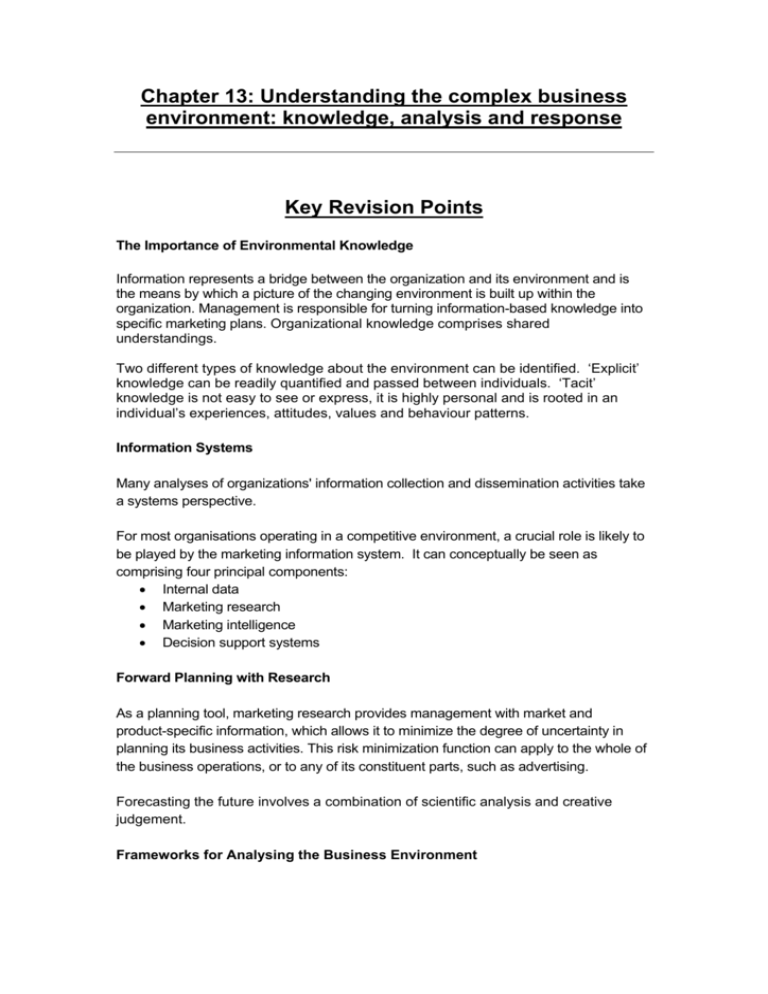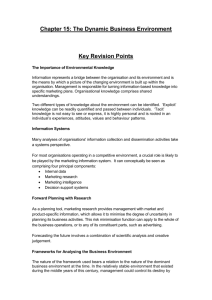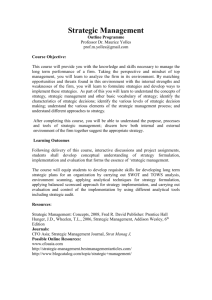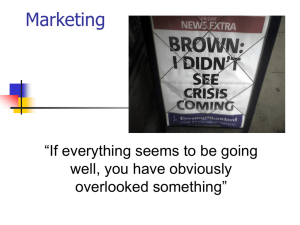CHAPTER 13: The Dynamic Business Environment: analysis and
advertisement

Chapter 13: Understanding the complex business environment: knowledge, analysis and response Key Revision Points The Importance of Environmental Knowledge Information represents a bridge between the organization and its environment and is the means by which a picture of the changing environment is built up within the organization. Management is responsible for turning information-based knowledge into specific marketing plans. Organizational knowledge comprises shared understandings. Two different types of knowledge about the environment can be identified. ‘Explicit’ knowledge can be readily quantified and passed between individuals. ‘Tacit’ knowledge is not easy to see or express, it is highly personal and is rooted in an individual’s experiences, attitudes, values and behaviour patterns. Information Systems Many analyses of organizations' information collection and dissemination activities take a systems perspective. For most organisations operating in a competitive environment, a crucial role is likely to be played by the marketing information system. It can conceptually be seen as comprising four principal components: • Internal data • Marketing research • Marketing intelligence • Decision support systems Forward Planning with Research As a planning tool, marketing research provides management with market and product-specific information, which allows it to minimize the degree of uncertainty in planning its business activities. This risk minimization function can apply to the whole of the business operations, or to any of its constituent parts, such as advertising. Forecasting the future involves a combination of scientific analysis and creative judgement. Frameworks for Analysing the Business Environment The nature of the framework used bears a relation to the nature of the dominant business environment at the time. In the relatively stable environment that existed during the middle years of this century, management could control its destiny by controlling current performance. In the turbulent environment of the 1990s, control becomes dependent upon management’s ability to predict the future and respond to change. Choice of Framework A range of analytic frameworks is available for companies to use in analysing their marketing environment and making strategic marketing decisions. The choice of framework will depend upon. • Level of turbulence • The cost associated with an inaccurate • Time-scale The Marketing Audit A Marketing Audit, which has been defined by Kotler (1997) as: “… a comprehensive, systematic, independent and periodic examination of a company’s or business unit’s marketing environment, objectives, strategies and activities with a view to determining problem areas and opportunities and recommending a plan of action to improve the company’s marketing performance.” The availability of good quality, timely information is crucial to undertaking a marketing audit. Swot Analysis A SWOT analysis summarises the main environmental issues in the form of opportunities and threats (O&T) facing an organisation. With this technique, these are specifically listed alongside the strengths and weaknesses of the organisation (S&W). Trend Extrapolation Demand forecasting takes the form of multiplying current sales by an historic growth factor. In most markets, this can at best work effectively only in predicting long-term sales growth at the expense of short-term variations. While multiple regression techniques can be used to identify the significance of historical relationships between a number of variables, extrapolation methods suffer from a number of shortcomings. At best, trend extrapolation can be used where planning horizons are short, the number of variables relatively limited and the risk level relatively low. Expert Opinion Expert opinion may be unstructured and come, either from a few individuals inside the organization, or from external advisers or consultants. Relying on individuals may give an incomplete or distorted picture of the future. There are, however, more structured methods of gaining expert opinion. One of the best known is probably the Delphi method. Scenario building Scenario building is an attempt to paint a picture of the future. It may be possible to build a small number of alternative scenarios based on differing assumptions. This qualitative approach is a means of handling environmental issues that are hard to quantify because they are less structured, more uncertain and may involve very complex relationships. Influence diagrams and impact grids A more applied approach is to assess the likely impact of specific aspects of environmental change on the business. One method is to construct influence diagrams so that a better understanding of the relationships between environmental forces can be obtained. Cross-impact analysis (CIA), will help managers to understand the possible relationships between forces in the environment. Environmental threat and opportunity profile (ETOP) In order for the environmental analysis to have a useful input into the business planning process, a wide range of information and opinions needs to be summarized in a meaningful way. The environmental threat and opportunity profile (ETOP) provides a summary of the environmental factors that are most critical to the company. Porter’s five forces model of industry competitiveness The five forces requiring evaluation are: the power of suppliers, the power of buyers, the threat of new entrants, the threat of substitute products and the intensity of rivalry between competing firms. Forming a view of environmental influence Considerations for senior management are whether the environment is simple or complex and stable or dynamic. Having completed an analysis of the business and marketing environment, ideally by means of a marketing audit, the information needs to be distilled into a SWOT summary.











